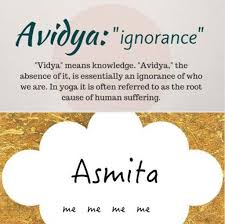How Do We Know??

How do we know what we don’t know? And, are we willing to open ourselves to the discomfort of changing habits so ingrained they feel like they are permanently part of us? These are a couple of the questions we pondered in our Yoga Sutra discussion group yesterday.
We were talking about the first two major obstacles that Patanjali writes about when we begin the practice of yoga. Very quickly we must understand that we are living with a “mistaken identity” (AVIDYA) – attaching ourselves to who we “think” we are with all our stories, opinions, and habitual thought – instead of living our actual Truth of the pure consciousness within. Those attachments to all the changing and transient things around and within us has built an ego (ASMITA) that does not serve us towards the purpose of stilling the fluctuations of consciousness, which is yoga.
AVIDYA (spiritual ignorance) is the foundation of all other obstacles and it is basically the forgetting that the Truth of who we are lies with the purusa, or the pure unchanging clear consciousness, instead of with all of our accumulated habits, thoughts, and stories that keep us in delusion and also mostly keep us in some sort of suffering.
ASMITA (Ego) is the attachment to all those changeable habits and thoughts and stories that are building blocks for a world of “self” that seems solid and true and right. With that ego, we then go out in the world and create judgement and impressions of “other” based on the story we think to be right.
To understand these obstacles and the ones to come, there are a few things to keep in mind...
1. The relationship of purusa and prakrti is a foundational understanding for yoga. Purusa is our “TRUE SELF” that is pure unchanging and undisturbed consciousness. Prakrti is everything else that is changing and changeable, our thoughts, our beliefs, our body, and all the matter outside our body as well – prakrti is Nature. The experience of our existence is based on the play of purusa and prakriti, two of the three eternal principles within the cosmology of yoga. The third eternal principle we discussed last time, Isvara, or the existence of a higher power.
2. Our changing consciousness (citta) that is part of prakrti does have three parts, one of which is also translated as ego (ahamkara). Ahamkara is the mere basis of being an individual that lives in a body in the world. It is the basic “I”, but it is free of attachment to story, habit, and judgement. It just is. The other two parts of citta are manas and buddhi. Manas is the collector of incoming mental information, and buddhi is the discriminating factor that can tell “this” from “that”.
3. Yoga also sees us as individuals dealing with layers or veils (koshas) of experience on many levels of being. The obstacles we face can be very visible and active, subtle and hard to see, or they may only show up every now and then. All of that can depend on how deeply they are ingrained and at what level. Annamayakosa is physical and anatomical, Pranamayakosa is the energetic or organic layer, Manomayakosa is the mental sheath, Vijnanamayakosa is the intellectual or wisdom sheath, and Anandamayakosa is the blissful sheath that is the covering of the self right before the experience of the pure consciousness of purusa.
Our practice of the 8-limbs of yoga is there to build discernment and awareness of all the layers of “stuff” we have accumulated in this and maybe other lifetimes, and understand what we can peel away and leave behind to get closer and closer to the reality of our True Self – purusa. But, we also have to understand that until that point of being in the experience of purusa we are all in the realm of prakrti, dealing with some amount of distraction and obstacle. This is not a “bad” or “good” thing, it is the experience of life. What yoga will bring is a steadiness and understanding of who we are and how we relate to the world around us. When that knowledge and awareness is accumulated, we can make better choices and see things more clearly, diminish our obstacles and let ourselves flow with life instead of against it.
I always say that if we have stuck with yoga for any amount of time it is because we have seen some result or had some glimpse of how this awareness and clarity is so freeing. Maybe it is the experience of pause and quiet after a long exhalation, maybe it is a perfect Savasana where all those layers fall away, maybe it is an experience of perfect balance or “alignment” in a pose or just the proving of past mental thoughts or habits wrong in practice, and maybe it is not in what we think of as “yoga practice on the mat” at all, but still an experience of “union” or bliss.
The first step of yoga is admitting this “ignorance” of who you really are and allowing the learning process to begin. All of our stories have curiosities and intricacies and the process of moving through obstacles can bring us a sense of lightness and strength. Take that step and be ready to start to get to know what you don’t know…